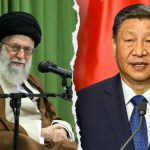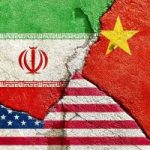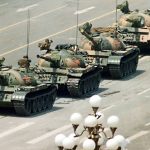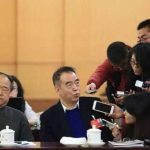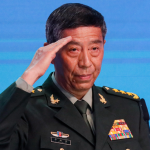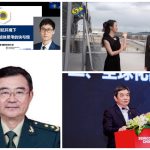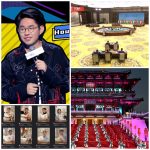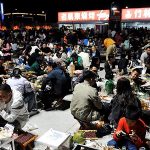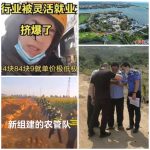Editor’s note: It has been said that nations have no friends, only interests. The interests of China and Russia currently coincide closely. But it was not always so. Below is testimony from someone deeply familiar with a 1969 battle between the forces of Cultural Revolution China and the former Soviet Union, along their long border. At the end it also describes how the Richard Nixon White House may have protected China from a nuclear attack. This piece is translated from Yibao Chinese by Evan Osborne.
In March 1969, the author went to the Sino-Soviet border area amidst the gunfire in and around Zhenbao Island (called Damansky Island in the Soviet Union), as the war was happening in the area. In the summer of 1973, the basketball team I belonged to played a friendly game with Chinese military personnel from the main force that had participated in the Zhenbao Island War, and later had dinner with the officers and soldiers. During the meeting, I learned that the company commander Zhou Dengguo had fired the first shot in the Sino-Soviet Zhenbao Island War. When I traveled to Russia later and talked to the Russian people about their impressions of China, most of them said that they could not trust it, and the most common question was, why did China attack the Soviet Union in March 1969? Why? The Russian people believed that the Chinese army had suddenly fired the first shot. On the 50th anniversary of the Zhenbao Island War in March 2019, large-scale anti-China demonstrations broke out in more than 50 major cities in Russia, which shows that the Russian people have not forgotten the war. According to the CCP’s official account, it was the Soviet army that fired the first shot, and the Chinese border guards were forced to fight back in self-defense.
Zhou Dengguo was the squad leader of the special-service company of the 133rd Division of the 46th Army of the Chinese People’s Liberation Army (the unit’s designation when he joined the war). While on patrol, he encountered a Soviet team led by the “lame captain” Ivan Strelnikov. He took up his submachine gun and shot dead the lame captain, who was hated by Chinese soldiers and civilians. In the ensuing battle, Zhou took over for the injured platoon leader. He played basketball quite well, as did the team from the unit involved in the Zhenbaodao battle. It is said that Sun Yuguo played basketball even better.

Image 1: This drawing depicts Zhou Dengguo in head-on combat with the Soviet unit commanded by “Lame Captain” Ivan Strelnikov. Picture source: Zhou Dengguo of the Ten Heroes of Zhenbao Island Battle https://www.sohu.com/a/55855836_180393.
Author’s note: Zhou Dengguo is the one on the left in the picture holding a submachine gun, and the person holding a pistol is Wu Yonggao, the platoon leader. This image was published shortly after the Zhenbao Island War.
1. Amidst the gunfire of the Zhenbao Island War, they went to the Sino-Soviet border area to go down [Cultural-Revolution style] and settle in there
In the Centennial Memorabilia of the Communist Party of China (July 1921-June 2021) [1]compiled by the Central Committee of the Communist Party of China Party History and Literature Research Institute, it is recorded:
“In March 1969, Soviet troops invaded Zhenbao Island on the Chinese side of the main channel of the Ussuri River, causing serious bloodshed. The Chinese border guards were forced to fight back in self-defense.
There are two points worth noting in this record. First, the Chinese government has always claimed that among the rivers that constitute the national border, the islands on the Chinese side of the main channel are Chinese territory. Second, Zhenbao Island is located on the Chinese side of the main waterway of the Ussuri River, which is Chinese territory. When Soviet troops entered Zhenbao Island, they invaded China. Therefore, the Sino-Soviet Zhenbao Island War was called the Zhenbao Island Self-Defense Counterattack.
But the fact is that until 1969, the Sino-Soviet border line had not been determined, and neither had the ownership of Zhenbao Island. Landing on it and patrolling by the border guards of China and the Soviet Union was the norm back then, and such actions by Soviet troops did not constitute an illegal invading of Chinese territory. Only if the Soviet border guards fired the first shot at the Chinese army would the Chinese border guards be justified in counterattacking in self-defense. Therefore, who fired the first shot and who planned the Zhenbao Island war in advance is the key to understanding the outbreak of the war. By the way, in the subsequent Sino-Soviet (Sino-Russian) border negotiations, many islands on the Chinese side of the main waterway did not become Chinese territory. I do not know how the Chinese Communist government explained this.

Figure 2: Zhenbao Island in the Ussuri River. On the the right side is the Soviet Union, and on the left side is China. The semicircular island in the picture is Zhenbao Island. To the right of Zhenbao Island is the main stream of the Ussuri River, and on the left is an offshoot subsidiary stream. Source: Raohe Regional Culture II.
According to the “Baidu Encyclopedia,” the Su Zhenbao Island War was divided into three battles[2], which occurred on March 2, 1969, March 15, 1969 and March 17, 1969.
The author left Hangzhou on March 9, 1969 to go down and join the second team of the Longyang Brigade, Erlongshan Commune, Fujin County, Heilongjiang Province, and arrived at the production team on the night of March 12. So the author and thousands of middle-school students in Hangzhou went down to the Sino-Soviet border area amidst the gunfire of the Zhenbao Island War. The distance between Fujin County, Heilongjiang Province and West Lake in Hangzhou is 4,000 kilometers, so the “eight thousand miles of road, cloud and moon” in [General] Yue Fei’s [attributed Song Dynasty poem] “Man Jianghong” is a phrase that the educated youth liked to recite.
After Mao Zedong issued a call for educated youths to go to the countryside in December 1968, a delegation from the Hejiang region of Heilongjiang Province came to Hangzhou to issue a mobilization report, denouncing Tsarist Russia’s crimes of killing Chinese residents and occupying 1.5 million square kilometers of land in Northeast China. At that time, the domestic news media were also full of patriotic propaganda in this regard, urging the defeat of Soviet revisionists. And recently, the China’s Ministry of Natural Resources has released its “Specifications for the Representation of Public Map Contents,” specifically listing 8 [Chinese-language] place names in Russia on the Sino-Russian border, in particular for Vladivostok, Shuangchengzi, Khabarovsk, Hailanpao, Sakhalin Island, Nerchinsk, Temple Street, and the Outer Xing’an Mountains[3]. These eight areas were once Chinese territory.

Figure 3: Patriotic education during that time, various locations. Source: Internet screenshot
Fujin County originally belonged to the Hejiang area of Heilongjiang Province (now Fujin City, subordinate to Jiamusi City), located in the Sanjiang Plain. The Three Rivers refers to the Songhua River, Heilongjiang River and Wusuli River, and parts of the Heilongjiang and Wusuli Rivers form the border between China and the Soviet Union. The Songhua River flows into Heilongjiang in Tongjiang County, and the Wusuli River flows into Heilongjiang in Fuyuan County, so both the Songhua River and the Wusuli River are tributaries of the Heilongjiang. Erlongshan Town, Fujin County historically was the seat of the county government of Tongjiang County. The Sanjiang Plain, also known as the Great Northern Wilderness, is located in the Sino-Soviet border area.
In fact, the Zhenbao Island War was not the first large-scale war between the Chinese and Soviet armies. The Fujin Naval Battle, aka the Tongjiang Naval Battle or the Sanjiangkou Naval Battle, between the Chinese and Soviet armies in 1929 was the first direct, large-scale battle between the two, face-to-face. As a result of this battle, 5 of the 6 warships of the Chinese Navy were sunk, and the remaining warship was seriously damaged and withdrew from the battlefield[4]. During the war, Tongjiang City fell, Fujin County fell, the Soviet army entered the city, and the people suffered. Many Chinese people don’t even know about this war between the [Nationalist] Chinese army and the Soviet Red Army. Since 1949, Chinese history classes have not dared to talk about it, let alone what is in the 100-year records of the Chinese Communist Party, because the Chinese Communist Party [not yet in power] was on the side of the Soviet Red Army at that time.
Fujin County, Tongjiang County and Fuyuan County are very different. Tongjiang and Fuyuan are border counties, and Fujin is not. Residents of Fujin who visited relatives in Tongjiang and Fuyuan needed to apply for a border pass. Frontier inspection stations were set up at the road junctions between Fujin, Tongjiang and Fuyuan. The Hangzhou educated youths who went to Fuyuan County set off in December 1968. Then the Hangzhou educated youths who went to the Great Northern Wilderness set off separately on March 6th and 9th, 1969. Those who went to Raohe, Hulin, and Suibin and those who went to Tongjiang set off on March 6th. Those who went to Fujin left on March 9th.
In China, people were divided into classes numbered three, six, and nine. Among the educated youths in Hangzhou, there were also grades within these classes. Those who went to the border counties of Tongjiang and Fuyuan belonged to the educated youths with good family status, and those who went to Fujin were educated youths with poor family status, the children of capitalists, reactionary academic authorities and of Kuomintang or foreign spies. These educated youth who went to the border counties of Tongjiang and Fuyuan immediately became the main militiamen, and had guns and grenades in their hands. Since the files of the educated youth who went to Fujin arrived later than others, they served as the basic militia for less than a month. When the archives of the educated youth reached Fujin, all the bullets in the hands of the educated youth in Hangzhou were handed over, not to mention the basic militia, even the ordinary militia, and the political treatment was the same as that of the children of the landlords and rich peasants. The family composition in the archives of Hangzhou educated youth in Fujin County can be described as unsightly[5].
The life for previously local wealthy and of rightists in the Sino-Soviet border area had been very difficult after the revolution. A landlord surnamed Hu in Longyangtun had been torn apart by five horses during land reform. Also during land reform Lao Mengtou, the chairman of the peasant association who had forced the landlords to divide the land, later married the landlord’s concubine, and so a female “Khrushchev” was sleeping next to him. During the [1963] Socialist Education Movement those who were beaten into confessing they were unclean cadres were forced to resign. In the Sino-Soviet border area, previously whenever the relationship between the two sides became tense, signal flares would inexplicably rise one after another on the endless plain, but those who fired the signal flares could not be caught.
At that time, militiamen from neighboring villages often disguised themselves as Soviet spies. (Soldiers from the same village also went to other villages to avoid being recognized.) When the moon was dark and the wind was gusting, wearing hoods and armed with pistols and sharp knives they would sneak into the homes of landlords and rich peasants and take them away. Go to the “Qingshazhang” (referring to the farmland where the crops grow high), press a dagger on the necks of the rich people, and ask them to explain where the village secretary’s house is and where the militia battalion chief’s house is. No one could resist, and all had no choice but to tell the general location of the homes of the village secretary and militia battalion commander in the village. The next day, the villagers would hold a struggle session, saying that the landlords and rich peasants had colluded with Soviet revisionism in their vain attempt to restore the Soviet Union. The scene of the meeting was no different from that of the Red Guard riots in the city.
I remember doing a “civil defense exercise” one day. Toward midnight, suddenly there were loud gunshots outside the village, and also the sound of explosions, and the dogs throughout the village barked. The horns connected to each household sounded, and the secretary yelled on the horn: “The old man is here! The old man is here! All the villagers gather at the brigade headquarters immediately! Gather at the brigade headquarters immediately!” For a while, the village cried; there was a great deal of shouting. The villagers helped the old and the young to rush to the brigade headquarters.
Unarmed educated young men lay on the kang [a flat surface common in northern China, used for sleeping, entertainment and other purposes] and began to tease: “Now it is time to fire he guns! One for each person.” There was applause, then someone said “It’s impossible!” Everyone was silent, and suddenly there was laughter. “One gun for two people.” Then more applause. Someone said, “They’re still made of wood.” He laughed. Even if Russians are really coming, what can we do without guns or cannons? The bitter laugh hid the tears in the corners of his eyes. A few years later, I saw a document in the Fujin County Armed Forces Department, saying that the Sanjiang Plain was a strategically abandoned area, because it faced no danger. The first military line of defense was in the Suihua area, hundreds of kilometers away from Fujin.
Jiang Kang’s humiliation awaits vengeance! When will the hatred of the underlings be extinguished [referring to a poem describing a war during the Northern Song Dynasty]?
In the following months and years, the documents enabling rehabilitation of the parents of these “educated youths” would come intermittently to the Fujin County Educated Youth Office.
2.He fired the first shot in the Sino-Soviet Zhenbao Island War
In the summer of 1973, the author went to Raohe County, Heilongjiang Province to play basketball with a team composed of educated youth from Hangzhou and Fujin. (Three of the Fujin educated youths have since passed away, and I hereby express my condolences). Raohe County is on the bank of the Wusuli River, next to Hulin County. Although Zhenbao Island is within the territory of Hulin County, it is far from there and close to Raohe County (see Figure 4). The main army station is also near Raohe County. The leaders of the border defense forces of China and the Soviet Union met regularly there and exchanged information. The meeting point on the Chinese side was also on the Ussuri River near Raohe County.

Figure 4: Schematic diagram of the location of Raohe, Hulin County and Zhenbao Island during the Sino-Soviet Zhenbao Island War. Source: screenshot from the Internet.
Before the outbreak of the war, most of the border conflicts between the soldiers and civilians of the two countries on each side of the Ussuri River occurred on the Ussuri River itself, near the county seat of Raohe County.
Every winter, due to the cold weather, the Heilongjiang and Wusuli rivers are frozen, and the ice is so thick that not only pedestrians, but also trucks and tanks can be driven across. Since the 1960s, the relationship between the two parties in China and the Soviet Union had deteriorated, and border conflicts gradually escalated. After the Ussuri River opened every year, border conflicts mostly occurred between ships of the two countries sailing on the river. In winter the Ussuri River is also frozen, and border conflicts often occurred it during these years. At first, it was just people on both sides pushing and shoving, and then soldiers without guns joined in, with fists and kicks and sticks flying. In this kind of border conflict, the Chinese side did not suffer from a disadvantage. One reason was that the Chinese side had a large number of people, and another is that most of the Chinese soldiers mixed among the common people knew martial arts and had extraordinary skills. But their most problematic disadvantage was that the Soviet tanks also came to join in the fun. The unscrupulous Soviet tanks could swagger into Raohe County for a circle, and then withdraw, as if entering no-man’s land. A friend from the Raohe County Sports Committee told the author that many residents of Raohe County personally went to the Wusuli River to form a human wall arm in arm to block Soviet tanks and defend the territory of the motherland. One day something tragic happened. A Soviet tank rushed at very high speed to the front of such a wall. People thought that the tank’s brakes failed and it lost control, and the human wall was shattered. The Soviet tanks began to chase the fleeing Chinese residents on the ice, and hysterical laughter came from the tanks from time to time. The chase continued for some time, and the Chinese residents became exhausted. Suddenly a resident slipped and fell on the river. The Soviet tanks following behind had no time to brake and ran over him. There was much bloodshed and death in the border clashes, and the conflict rose to new heights.

Figure 5: Pushing and shoving during the Sino-Soviet border conflict. Source: Internet screenshot
The quality of the basketball court where the main troops of Zhenbao Island were stationed was very good, better than that of Raohe County. The basketball skills of the army officers and soldiers were good. It seems that playing basketball was the main way they spent their spare time. Sun Yuguo, the company instructor back then, has been transferred to the Shenyang Military Region as the deputy commander. I heard that Sun Yuguo liked to play basketball and was a good player. After the Battle of Zhenbao Island, many commanders and fighters of the company were transferred to other units and promoted. After the fall of the Gang of Four, Sun Yuguo was purged, later changed jobs at the regimental level, and went to work as a cadre in a factory in Shenyang.
The basketball game with the officers and soldiers was very enjoyable. After the game, the company leader invited us to have dinner with the commanders and fighters. The dinner was very lush, with pork raised by the company itself, local delicacies (mushrooms and other fungi, etc.), hard liquor and beer. The person who fell under the drinking table was a coach of our team. (When drinking in the northeast region, if no one falls down, it means that the drink is not good, and it doesn’t really measure up.) At the dinner table, the company leader told us the whole sags of the Zhenbao Island War, and some details were different from CCP media reports. There are two that impressed me the most. One was that Zhou Dengguo killed the crippled captain Ivan of the Soviet Army by firing the first shot during his patrol. The other was that Soviet tanks were captured only after the Chinese suffered many casualties.
Zhou Dengguo, the company commander at that time, also played basketball with us, and his skills were also quite good. After the game, he had dinner with us and we talked about the mountain events. He did not deny that he fired the first shot of the Zhenbao Island War, killing the crippled Soviet captain Ivan.
In order to commend the heroic deeds of the Heilongjiang frontier defense forces, the Central Military Commission issued an order on July 30, 1969, giving awards to Sun Yuguo, Du Yongchun, Hua Yujie, Zhou Dengguo, Leng Pengfei, Sun Zhengmin, Yang Lin, Chen Shaoguang, Wang Qingrong, Yu Qingyang and 10 other officers and soldiers. One citation for being a “battle hero” was given to each of the 10 units of the border defense force, including the reconnaissance company, the first company and the border defense station[6].
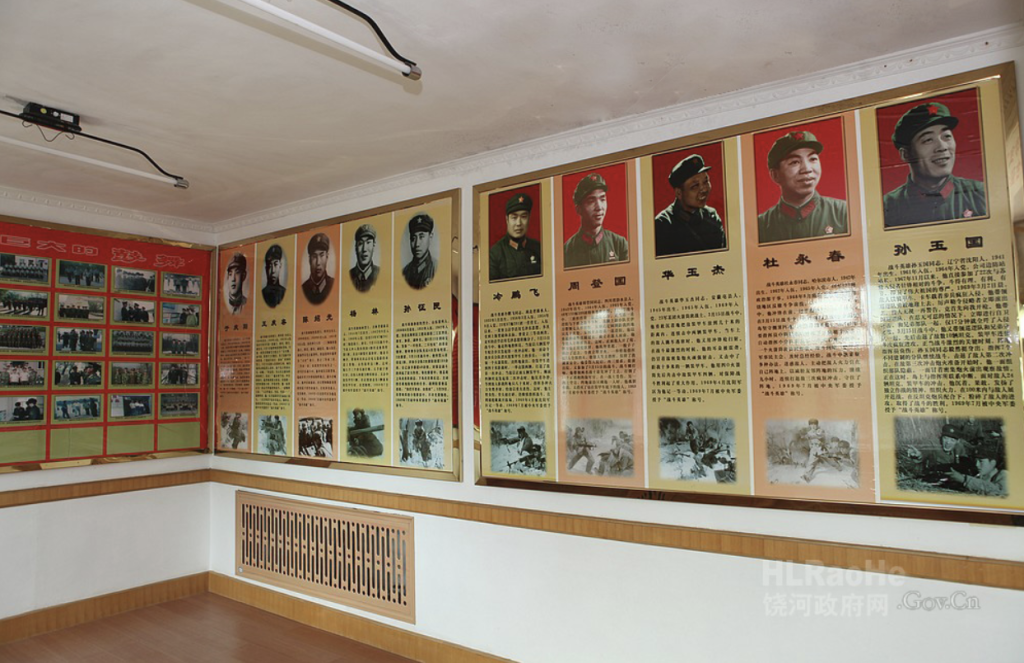
Figure 6: Photos and deeds of several heroes in the Zhenbao Island Memorial Hall, rebuilt from the barracks of the Raohe Army. The first person from the right is Sun Yuguo, and the fourth person from the right is Zhou Dengguo. Among the pictures of deeds is one of Zhou Dengguo shooting with a submachine gun and killing the lame captain Ivan of the Soviet army. Source: Raohe Regional Culture II: Red Treasure Island, http://www.raohe.gov.cn/tprh/hsbd/hsbd.htm
3. Killing the lame captain Ivan of the Soviet army
In fact, what happened is very simple, very clear. The following is a summary of the author’s memories, in part based on related information on the Internet.
First, the Sino-Soviet Zhenbao Island battle, which took place on March 2, 1969, was a planned annihilation battle that lured the enemy into the ambush circle that the Chinese People’s Liberation Army had arranged in advance.
The entire war plan was proposed by the Shenyang Military Region and approved by Mao Zedong, Lin Biao and Zhou Enlai, and the final battle was fought at Zhenbao Island. Because Zhenbao Island is on the Chinese side of the main route of the Ussuri River, fighting here it was easy to reveal the aggressive behavior of the Soviet army. In addition, the terrain was favorable to China. There are many mountains and dense forests on the Chinese side, which is conducive to the hiding and maneuvering of troops, but not conducive to the attack by mechanized troops using Soviet tanks and armored vehicles. The timing was chosen before the Ninth Congress of the Communist Party of China (held from April 1 to 24, 1969) to provide the needed political atmosphere and a so-called great victory for the party congress. For this reason, the Shenyang Military Region transferred the most capable company from among its troops. On February 26, 1969, the instructions and specific combat plans of Mao Zedong, Lin Biao and Zhou Enlai were communicated to the combat troops. In the combat plan, there was a specific combat goal of eliminating the Soviet “Lame Captain” Ivan. Ivan’s full name was Ivan Strelnikov. Because Strelnikov’s surname was too long, the Chinese often referred to him as Ivan. Strelnikov was originally a lieutenant. He committed a lot of evil in the border conflict. He was injured by a Chinese sniper and became a “cripple.” But the Soviet army praised Strelnikov as a hero, promoted him to captain, and appointed him as the head of the border station. His military rank and position were comparable to that of Sun Yuguo in China.
In addition, while the raid on the Soviet patrol was planned, it was probably providence that the first shot that day killed “Captain Lame.” The purpose of the raid, recall, was to lure Soviet troops into a pre-arranged encirclement.
On the evening of March 1, commanders and fighters of the three companies of the Chinese People’s Liberation Army lurked on Zhenbao Island. On the morning of March 2, China sent two patrol teams to board Zhenbao Island to carry out fishing expeditions. One team was led by company instructor Sun Yuguo, the other by platoon leader Wu Yonggao. Zhou Dengguo was the squad leader at the time and was in the patrol team led by Wu Yonggao. Before the departure of the two teams, the commanders and fighters wrote of their determination and blood, and paid their “final party dues.” Knowing the magnitude of the mission and that who would live and die would be unpredictable, they shared Jing Ke’s tragic feelings of assassinating the King of Qin. “The wind rustles and the water chills, and many a magnificent man will not return.” On that day, Captain Strelnikov also brought 30 officers and soldiers, an armored vehicle and two trucks to patrol. Captain Strelnikov led 6 soldiers to land on Zhenbao Island, and then more than 20 followed behind them, in total forming two echelons in battle.
After the establishment of diplomatic relations between China and the Soviet Union on October 2, 1949, the two sides did not determine the border. In particular, the hundreds of islands on the Heilongjiang River and the Ussuri River did not have specific ownership, and personnel from both countries could go to the islands. The same went for Zhenbao Island. Before March 2, 1969, the border guards from both China and the Soviet Union went to the island to patrol. When the two sides met, they waved and greeted each other in a friendly manner, and clasped shoulders as they passed. However, the Sino-Soviet border guards each built observation towers more than ten meters high on their banks of the Ussuri River. The sentries on the observation towers monitored every move of the troops on both sides, especially the patrols.

Figure 7: The observation tower (also known as the sentry tower) on the Soviet side. Source: Phoenix News
The patrol team led by platoon leader Wu Yonggao happened to meet Captain Strelnikov’s patrol team. When the two patrol teams walked towards each other less than 10 meters away, the two leaders each gestured with their hands. At this time, the soldiers of the Chinese patrol suddenly moved away, and the squad leader Zhou Dengguo behind them took up the submachine gun with the safety device already released and loaded with bullets, and shot the “lame captain” Ivan and others to death. Seeing this, supporting Soviet troops who behind came to reinforce their men. The two Chinese patrols drew the Soviet forces into the pre-arranged encirclement as planned, and the Soviet army suffered heavy losses.
The sentry on the Soviet observation tower issued an alarm, and then the Soviet army came to take revenge in four armored vehicles accompanied by armed helicopters. The Chinese side suffered considerable damage.
Regarding the course of the battle on March 2, 1969, there are two different versions[7].
4.”People’s Daily” and “Liberation Army Daily” jointly publish the editorial “Down with the New Czar!”
On March 2, 1969, the Chinese Ministry of Foreign Affairs submitted a protest note to the Soviet embassy in China[8]. The full text read as follows:
To the Embassy of the Soviet Union in China:
“On the morning of March 2, 1969, Soviet border guards invaded the Zhenbao Island area of Heilongjiang Province, China, and shot, killed and wounded many members of our border guards, creating an extremely serious armed conflict on the border. For this reason, the Ministry of Foreign Affairs of the People’s Republic of China has been ordered to lodge the strongest protest to the Soviet government.
At 9:17 on March 2, Soviet border guards dispatched a large number of heavily armed soldiers, four armored vehicles and automobiles, openly invaded the undisputed Zhenbao Island area of China’s territory, and carried out rampant attacks on the Chinese border guards who were performing normal patrols. In a provocation, the Soviet forces first opened fire and killed and wounded many of our border guards. Our border guards were forced to fight back in self-defense when repeated warnings to the Soviet border guards were ineffective and our guards could not continue to endure it. This serious bloodshed was entirely caused by the Soviet authorities. This is another new serious crime in the long-term deliberate violation of Chinese territory by Soviet authorities, with armed provocations and continuous bloodshed.
The Chinese government firmly demands that the Soviet government punish the perpetrators of this incident, immediately cease armed provocations and violations of Chinese territory, and reserves the right to ask the Soviet side to compensate us for all losses. The Chinese government once again solemnly warns the Soviet government that China’s sacred territory is inviolable. If you continue to provoke armed conflicts on the Sino-Soviet border, you will be resolutely resisted by the Chinese people. Full responsibility rests with the Soviet government.”
The Chinese Ministry of Foreign Affairs divided the Sino-Soviet Zhenbao Island Battle on March 2, 1969 into two time periods, one on the morning of March 2, 1969, and the other after 9:17 on the same day. In the first time period, the patrol team led by “Lame Captain” Ivan met Zhou Dengguo’s patrol team and the captain was shot dead. In the second time period, Soviet border guards dispatched a large number of heavily armed soldiers, four armored vehicles and cars to retaliate, and both sides suffered casualties. The Chinese Ministry of Foreign Affairs emphasized that the Zhenbao Island area is China’s undisputed territory, and it was the Soviet border guards who invaded Chinese territory. This was taken into account when the battle location was chosen as Zhenbao Island when the battle plan was first drawn up.

Figure 8: On March 4, 1969, “People’s Daily” and “Liberation Army Daily” published an editorial, “Down with the New Tsar!” Editorial photo source: People’s Daily
On March 4, 1969, “People’s Daily” and “Liberation Army Daily” jointly published an editorial with the title “Down with the New Czar! [9]. The editorial said: “On March 2, the Soviet revisionist renegade group dispatched armed forces to brazenly invade Zhenbao Island on the Ussuri River in China’s Heilongjiang Province, and they opened fire, killing and wounding many Chinese People’s Liberation Army border guards. This extremely grave border armed provocation was a crazed anti-China incident launched by the Soviet revisionists, and it was another major exposure of the jackal nature of Soviet revisionist social imperialism. The Chinese people and the Chinese People’s Liberation Army express their great indignation and the strongest protest against this heinous crime committed by the Soviet revisionist traitor clique. This serious border armed provocation was completely planned and deliberately fabricated by the Soviet revisionist traitor clique. Zhenbao Island is on the Ussuri River and is within China’s territory. It is our sacred right to have the personnel of our border guards to patrol our own land. However, the Soviet revisionist authorities dispatched a large number of armed forces, armored vehicles, and trucks to invade our territory and attack our patrol troops. Our frontier guards have issued warnings to the Soviet revisionist border guards many times, but they are still ineffective. Only under such intolerable circumstances were our border guards forced to counterattack in self-defense, punishing the provocateurs as they deserved, and successfully defended our country’s sacred territory. The military and civilians of our country express their firmest support for the just actions of the heroic border guards in defending the territorial sovereignty of the motherland.”
Note that the simultaneous editorials from “People’s Daily” and “Liberation Army Daily” no longer subdivide the battle unit two time periods, and mainly state what happened in the second time period.
On March 4, 1969, demonstrations to overthrow the Soviet “new tsar” broke out across China, and slogans to overthrow Soviet revisionism resounded in the sky over the country.

Figure 9: Advertisement for the documentary “The Anti-China Atrocities of the New Tsar: Soviet Revisionist Provocations on the Ussuri and Heilongjiang Rivers.” Source: screenshot from the Internet

Figure 10: March 4, 1969, Parade against “Soviet revisionists” in front of Tiananmen Square in Beijing. Source: screenshot from the Internet
5. On March 12, a serious fight occurred on a train among educated youths, and they were finally kicked off the train by the People’s Liberation Army
On March 9, 1969, the author and more than 1,000 educated youths from Hangzhou boarded a train at the Nanxingqiao Freight Yard in Hangzhou and rushed to the Great Northern Wilderness. The first battle on Zhenbao Island had just ended. After the train passed Suihua in Heilongjiang Province after more than three days of travel, violent conflict broke out among the educated youths in Hangzhou on the train[10]. Maybe it was the continuation of factional struggles during the Cultural Revolution, maybe it was three days and nights without sleep, or, more likely, it was the violent venting of suppressed emotions. The fight started when several girls (one of whom died 18 days later) were humiliated by someone while they were eating lunch in a dining car. After other boys from the same school found out about it, they went to find out what was going on. There were too many words to clarify things, so I started to act. Surprisingly, during the Cultural Revolution, many educated youths always carried weapons such as hand buckles, knives, daggers, three-section cudgels, nine-section whips, and armed belts. There were a few students from Xuejun Middle School, so they retreated to the first carriage and guarded the door. The hardboard seats in the car were removed and used to block the door, like a street barricade. When the train stopped on the platform, the fighting turned into an offensive battle from the platform while those on the train waged a defensive battle, and some window glass was shattered. As the train started to move, a cold wind entered the compartment and the temperature dropped sharply. Fortunately, the heating was still working. When the train arrived in Jiamusi City, many soldiers of the People’s Liberation Army with live ammunition boarded the train, which was put under military control. Those of us callow students too young to know either the heights of the sky or the depths of the earth asked the soldiers to deal with the murderer, otherwise we would not get off the bus. We didn’t know it, but at that time, the railway line was nervously transporting troops and war materials, preparing for the second battle of Zhenbao Island three days later. When the train arrived at Fulitun Station in Jixian County, more than 1,000 middle-school students were kicked off the train by PLA soldiers. A train loaded with a large amount of military supplies was parked to the side at the station, and this was the terminus of our train at that time. From Fulitun Station in Jixian County, we took the highway, passed through Baoqing County to Raohe, and reached the front line of Zhenbao Island.
The educated youth got into the car, and after a few hours’ bumpy ride, they arrived at Beidahuang village, where they jumped in the queue at about midnight. The scene here was completely different from what they imagined. What they faced was not re-education, but the reality that they were exiled. People seemed to have forgotten the fight on the train that had just occurred. Everyone had to face their new, difficult life, where the most important thing was to survive.
6. Soviet-made T62 tanks
On March 15, 1969, another battle broke out.
This battle was the Soviet army’s revenge for March 2, but China was also fully prepared for this vengeance, as evidenced by their deployment of troops before March 15. The Chinese side invested in a main infantry regiment, and the Soviet side invested in a mechanized motorized infantry regiment. The Soviet army used cannons, self-propelled rocket launchers, armored vehicles, aircraft, etc., as well as three of their latest T62 tanks. The battle was a stalemate and lasted nine and a half hours, with Zhenbao Island changing hands eight times. The biggest loss of the Soviet army was the death of the joint-force commander Colonel Leonov, and a T62 tank, the latest model at that time, fell into the hands of the Chinese side, its biggest gain.
Facing the rampaging Soviet tanks, the human wall formed by the Chinese forces could no longer hold. Fighting in middle and middle battles is useless. During the battle, the Chinese commanders found their anti-tank guns, recoilless guns, rocket launchers, and explosives had no effect on the T62. The People’s Liberation Army soldiers used their bodies to hold explosives to blow the tank up, but this didn’t work either. This tank was finally outflanked from the river behind Zhenbao Island. The track on one side of the tank was blown up by an anti-tank mine pre-buried in the Ussuri River near the island. The tank’s track fell off, and the driver abandoned the tank to escape. The tank remained in the Ussuri River between the Chinese shores and Zhenbao Island, very close to Chinese territory. Some say that according to the inspection of the tank afterwards, a small hole was found in the weakest spot between the tank track and the track fender. It should have been hit by a 40mm rocket, but the probability of this was very low, like being hit on the head by a meteorite. [11].

Figure 11: Captured Soviet-made T62 tank. Source: Internet screenshot

Figure 12: On March 15, 1969, Soviet tanks and armored vehicles appeared on the Wusuli River (Jiang Branch) between Zhenbao Island and Chinese territory. Source: Internet screenshot
The leaders for the Shenyang Military Region reported the battle situation on March 15 to the Central Military Commission, Mao Zedong, Lin Biao, and Zhou Enlai, and specifically mentioned that the CCP’s anti-tank weapons were ineffective against T62 tanks. This news shocked Mao, Lin, and Zhou. The highest level of the CCP issued an urgent order to get this tank back to Beijing at all costs. Similarly, high levels of authority in the Soviet Union also issued an order that China must not be allowed to obtain this tank.
The battle on March 17 had revolved around this tank now lying in the river. The Soviet army sent a special team to blow up the tank with explosives, but it was repulsed by Chinese artillery fire. When this plan failed, another was made. The Soviet army concentrated artillery fire on the tank, blasting the ice where it was located, and it sank to the bottom of the river.

Figure 13: Chinese artillery took advantage of the terrain to attack the Soviet army from the woods along the bank. Hidden in the woods, many tractors were then needed to drag the Soviet tank out of the river and onto Chinese territory. Source: Internet screenshot.
Fortunately, the Wusuli River is not deep at this location. After March 17, the Chinese side sent divers to detect the underwater tank and hung steel cables on it. Arranging multiple tractors on the shore, they tried to use them to pull the sinking tank to Chinese territory. The Soviet army used artillery fire to try to prevent this. As soon as a tractor was started, the Soviet army fired shells one after another until the roar of the tractors was no longer heard. Due to these many tractors being such large targets, under the fierce attack of Soviet artillery fire the Chinese tractor drivers suffered serious casualties. The Chinese side used artillery fire to provide cover for the implementation of their plan, trying to suppress the Soviet artillery fire with their own, and taking advantage of pauses in Soviet fire. The tug-of-war between the two sides lasted for more than a month until the night of April 27. Then, the Soviet army fell to Chinese operations at night. The Chinese tractors were still roaring under the Soviet artillery fire, and batches of Soviet artillery shells flew over. The Chinese side had switched to two artificial winches, and salvaged the tank silently and dragged it to Chinese territory after several twists and turns. According to the officers and soldiers at the dinner table, although the track on one side of the tank fell off, it had still been drivable. This tank was transported to the 6409 factory of the People’s Liberation Army in Fushun, Liaoning (an overhaul facility for People’s Liberation Army tanks), and then made a short stop in Shenyang. The tank came to Beijing in early June, and finally found its final home in the Chinese People’s Military Museum.

Figure 14: The Soviet-made T62 tank in the Chinese People’s Military Museum. Source: Chinese People’s Military Museum Network.
According to the article “The Zhenbao Island Incident I Know”[12], posted online by Professor Yang Fan, “The research on the tank yielded several surprises for the military. The first surprise was that the tank was equipped with a high-power diesel engine, weighed 37 tons, and had speeds as high as 50 kilometers per hour. Second was the large-caliber 115mm smoothbore tank gun, whose armor-piercing projectile could easily destroy any tank in our army. Third was the bistable shooting controller, which could shoot on the move, while our tanks had to stop when shooting, making them very easy targets for the enemy. Fourth, it had infrared night vision equipment with a visual distance of 1000 meters at night, so they could fire when still not in range of our tanks. Fifth, the opponent’s solid armor made all our anti-tank weapons useless.”
With the captured Soviet-made T62 tank, the military’s industry department designed large-scale anti-tank weapon weapons[13]. They were put into production, and continued until the 1980s. The Red Arrow-73 anti-tank missile and the 86-type 100mm anti-tank gun could effectively deal with even the Soviet T-72 tank, which basically solved the need for combat readiness at that time as China’s anti-tank equipment took a big step forward. However, when it comes to the improvement of the technical level and quality of tanks produced in China, the CCP kept silent about the significance of this captured Soviet-made T62 tank, and did not talk about how much new technology was created from the acquired tank.
According to the notes on the Zhenbao Island incident in Wikipedia, in the end, during the conflict, the Chinese border guards claimed to have killed or injured more than 230 Soviet soldiers (the Soviet Union announced that the number of Soviet casualties was 152), and the Chinese border guards had 92 casualties.
According to the article “How many casualties did the PLA suffer in the Zhenbao Island Self-Defense Counterattack?”[14], in the battle on March 2, 1969, 31 Soviet soldiers were killed and 14 injured and 20 Chinese soldiers were killed with 35 injured. 1 person was missing. On March 15, the Soviet army killed more than 60 and injured more than 80. 12 Chinese soldiers died and 27 were injured. In the battle to recover the tank after the 15th, 30 Soviet troops were killed and more than 30 people were injured, and the Chinese side did not report any losses. The article concluded that during the entire Zhenbao Island self-defense counterattack, the Chinese frontier guards killed and injured more than 230 Soviet soldiers (the Soviet Union announced that the number of Soviet casualties was 152), and 71 Chinese soldiers were killed (as of November 1969). 68 of the Chinese are now buried in the Martyrs Cemetery of Zhenbao Island, in Baoqing County. There are two in the Ximan Martyrs Cemetery in Qiqihar, and one in the Eighteen Stations Martyrs Cemetery.
The announced Chinese casualties, whether 92 or 71, are only the casualties among the border guards. In the process of snatching the Soviet tank, the tractors were driven not by border guards, but by ordinary Chinese people, who could be called militiamen or migrant workers. The number of their casualties has never been announced. It is said that there were more than 200 who died in the Great Northern Wilderness. This is the bulk of the loss of personnel.
7. It was again the Americans who saved China
After the Zhenbao Island War, the situation on the Sanjiang Plain became more tense, and both China and the Soviet Union increased their troops in the border areas. There were only two platoons of Chinese radar soldiers stationed in Fujin County, and there was only one anti-aircraft gun in the whole county.
On August 13, 1969, Chinese border guards were patrolling the Sino-Soviet border area of Tirekti, Yumin County, Xinjiang. It was ambushed by the Soviet army, and all 20 patrol officers and soldiers died. This was Soviet retaliation for the attack on Zhenbao Island.
It was said that the Soviet Union was going to carry out a “surgical nuclear attack” on China, targeting major cities such as Beijing and missile-launch bases elsewhere in the country. At this time, the United States took action to save China yet again.
In the article “The United States Has Helped China Overcome Seven Times in History” [15] Zi Zhongyun says that in 1969, the United States stopped the Soviet Union’s nuclear attack on China and saved China for the fifth time.
Zi Zhongyun wrote: “On August 20, Dobrynin, the Soviet ambassador to the United States, was ordered to meet urgently with Dr. Kissinger, Assistant to the President of the United States for National Security Affairs, in Washington, and inform him of the Soviet Union’s intention to launch a nuclear strike against China. Dobrynin was asked to seek the opinion of the US side. The US government after considerable thought came up with an incomparably brilliant way to expose this matter—the US sold out the Kremlin. The US government gave the news to a newspaper, and the news was passed on to China. On August 28, the “Washington Star” published a story in a prominent position, titled “The Soviet Union intends to conduct a surgical nuclear strike on China.” Then the US government stated to the Soviet Union that if a nuclear missile left the borders of the Soviet Union, the United States would believe that World War III had broken out, and all cities in the Soviet Union were within the range of nuclear missile strikes by the United States. At the critical moment, our ‘enemy’ the United States once again saved China.”

Figure 15: Why did the Soviet Union give up its “surgical nuclear strike” against China? Source: www.bilibili.com, www.yibaochina.com
The past is a guide for the future. It is a pity that the Chinese people and media, especially the top leaders of the CCP are often forgetful.
References:
[1] 中共中央党史和文献研究院:中国共产党一百年大事记(1921年7月-2021年6月),新华网,2021年6月28日 (Central Committee of the Communist Party of China Party History and Literature Research Institute: Chronicle of the Centennial Events of the Communist Party of China, July 1921-June 2021, Xinhuanet, June 28, 2021), https://www.xinhuanet.com/2021-06/28/c_1127603399.htm.
[2] 《百度百科》字条:珍宝岛自卫反击战 (Baidu Encyclopedia, “Self-defense counterattack on Zhenbao Island”), https://baike.baidu.com/item/%E7%8F%8D%E5%AE%9D%E5%B2%9B%E8%87%AA%E5%8D%AB%E5%8F%8D%E5%87%BB%E6%88%98/1222207
[3]中共下令中俄邊境8地名加註中國舊稱 網民:準備收復失土?,自由亚洲电台,2023年2月23日 (“The CCP ordered the addition of the previous Chinese names for 8 places on the Sino-Russian border. Netizens: Ready to recover lost land?”, Radio Free Asia, February 23, 2023), https://www.rfa.org/cantonese/news/map-02232023023831.html.
[4]王维洛:1929年中苏富锦海战(三江口海战),议报,2021年5月15日 (Wang Weiluo: Sino-Soviet Fujin Naval Battle (Sanjiangkou Naval Battle) in 1929, Yibao Chinese edition, May 15, 2021), https://yibaochina.com/?p=241929
[5]王维洛:杭州知青的檔案袋——懲罰紅衛兵的真憑實據,欧洲之声,2021年1月6日 (Wang Weiluo: Portfolio of Hangzhou Educated Youth——True Evidence for Punishment of Red Guards, Sino Euro Voices, January 6, 2021), https://sinoeurovoices.com/news/3835.
[6]王学亮:“珍宝岛战斗英雄”孙玉国的沉浮人生,来源:红色边疆荒友家园,2016年1月12日 (Wang Xueliang: The Ups and Downs of the “Zhenbao Island Fighting Hero” Sun Yuguo, Red Frontier Desolate Friends Home, January 12, 2016), http://www.xinfajia.net/13360.html.
[7]萨沙:苏军伏击解放军还是解放军伏击苏军?文学城网,2021年3月23日,https://bbs.wenxuecity.com/memory/1440006.html,司馬當:1969年中蘇邊界真相:毛澤東的冒險幾乎使中國遭受蘇聯核打擊,阿波罗网,2016年2月22日, https://tw.aboluowang.com/2016/0222/696523.html,苏联揭秘珍宝岛事件真相:中共早有预谋, 阿波罗网,2015年3月5日,https://www.aboluowang.com/2015/0305/523179.html,刘野山:中苏边界战争的真相,阿波罗网,2017年6月19日, https://www.aboluowang.com/2017/0619/948185.htmlyibaochina.com
(Sasha: The Soviet army ambushed the People’s Liberation Army or the People’s Liberation Army ambushed the Soviet army? Wenxuecity Network, March 23, 2021, https://bbs.wenxuecity.com/memory/1440006.html; Sima Dang: The Truth About the Sino-Soviet Border in 1969: Mao Zedong’s Adventure Almost Brought China a Soviet Nuclear Strike, Apollo.com, February 22, 2016, https://tw.aboluowang.com/2016/0222/696523.html; The Soviet Union reveals the truth about the Zhenbao Island incident: The CCP planned it early on, Apollo.com, March 5, 2015, https: //www.aboluowang.com/2015/0305/523179.html; Liu Yeshan: The Truth About the Sino-Soviet Border War, Apollo.com, June 19, 2017, https://www.aboluowang.com/2017/0619/948185.html)
[8]苏联边防军侵入我黑龙江省珍宝岛地区制造极为严重的流血事件 我国政府向苏联政府提出最强烈抗议,人民日报,1969年3月3日 (Soviet border guards invaded the Zhenbao Island area of Heilongjiang Province and caused extreme bloodshed; the Chinese government lodged the strongest protest to the Soviet government. People’s Daily, March 3, 1969) https://cn.govopendata.com/renminribao/1969/3/3/1/#384087
[9]人民日报、解放军报社论:打倒新沙皇!1969年3月4日 (People’s Daily, People’s Liberation Army Daily editorial: Down with the new tsar! March 4, 1969), https://cn.govopendata.com/renminribao/1969/3/4/1/
[10]王维洛:检验“知识青年上山下乡”政策的唯一标准,民主中国,2018年11月29日 (Wang Weiluo, The Only Standard by Which to Test the Policy of “Educated Youth Going to the Countryside”, Democratic China, November 29, 2018), https://minzhuzhongguo.org/default.php?id=86735
[11]杨帆教授:我所知道的珍宝岛事件,来源:Professor Yang Fan: What I know about the Zhenbao Island incident, All Things Known), https://weibo.com/1347411011/MdmFbiaPY#comment
[12]Ibid.
[13] 惊心动魄的珍宝岛T-62争夺战,我军在零下30摄氏度低温打捞坦克!刊登在搜狐网,2020年8月14 日 (In the Dramatic Battle for the T-62 on Zhenbao Island, Our Army Salvaged a Tank at Minus 30 Degrees Celsius! Published on sohu.com, August 14, 2020), https://www.sohu.com/a/413035307_100108207
[14] 珍宝岛自卫反击战解放军究竟伤亡了多少?2018年3月2日,刊登在搜狐网 (How many casualties did the People’s Liberation Army suffer in the self-defense counterattack on Zhenbao Island? Published on sohu.com, March 2, 2018), https://www.sohu.com/a/224687755_166075
[15] 资中筠:历史上美国曾七次帮助中国度过难关,2020年3月29日,刊登在长岛中文网 (Zi Zhongyun: The Seven Times in History the United States has helped China Overcome Difficulties, published on Long Island Chinese Network on March 29, 2020),
(This article was first published in translation by Yibao English. If you post it elsewhere cite the original URL, https://yibaochina.com/?p=249686)
(The views of the author do not represent those of this journal.)




